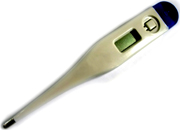|
 Thyroid Science
4(3):CLS1-9, 2009
Thyroid Science
4(3):CLS1-9, 2009
Axillary Electronic and
Galinstan Thermometer Measurements:
A Comparison of Their Consistency

Full
Text Free (pdf)

John C. Lowe*

*Director of Research, Fibromyalgia Research Foundation

Contact:
drlowe@FibromyalgiaResearch.org,
drlowe@drlowe.com
|
 Abstract.
Broda
Barnes’ publications have influenced
many clinicians to use the basal
body temperature in diagnosing
hypothyroidism and determining
patients’ dosages of thyroid
hormone. Barnes recommended that
patients use inexpensive and
reliable portable mercury-in-glass
thermometers. These are no longer
available, so many clinicians now
recommend that patients use either
electronic thermometers or Galinstan-in-glass
thermometers that are mercury-free.
Researchers have compared the
temperature readings of mercury
thermometers with both those of
electronic and Galinstan
thermometers. However, no studies
could be found in which measurements
with electronic thermometers were
compared to those of Galinstan
instruments. The purpose of this
study was to compare measurements
with these two types of
thermometers.
Methods: To avoid variations between subjects
and anatomical sites, measurements
were taken by one subject using the
left axilla. The subject took 10
measurements simultaneously with an
electronic and a Galinstan
thermometer. Two electronic
thermometers (E-1 and E-2) were
compared separately with two
Galinstan thermometers (G-1 and G-2)
so that four sets of 10 paired
measurements were taken.
Results:
The correlation between measurements
with the four pairings of electronic
and Galinstan thermometers was
strong and statistically significant
(E-1 & G-1, r = 0.985 ± 0.674 vs
0.638, p < 0.0001. E-1 & G-2,
r =
0.945 ± 0.302 vs 0.272,
p < 0.0001.
E-2 & G-1,
r = 0.980 ± 0.587 vs
0.627,
p < 0.0001. E-2 & G-2,
r =
0.976 ± 0.671 vs 0.529,
p <
0.0001.). Also, differences between
mean measurements using pairs of
thermometers were not statistically
significant (E-1 & G-1, 97.266 ±
0.674°F vs 97.190 ± 0.638°F,
p =
0.798. E-1 & G-2, 97.327 ± 0.302°F vs 97.193 ± 0.272°F,
p = 0.309. E-2
& G-1, 97.016 ± 0.587°F vs 97.107 ±
0.627°F,
p = 0.743. E-2 & G-2,
96.638 ± 0.671°F vs 96.841 ±
0.529°F,
p = 0.462. For metric
values, see Table 1).
Conclusion:
Readings using electronic and Galinstan thermometers from the same
axilla of one subject were
consistent enough to be of reliable
clinical use. Abstract.
Broda
Barnes’ publications have influenced
many clinicians to use the basal
body temperature in diagnosing
hypothyroidism and determining
patients’ dosages of thyroid
hormone. Barnes recommended that
patients use inexpensive and
reliable portable mercury-in-glass
thermometers. These are no longer
available, so many clinicians now
recommend that patients use either
electronic thermometers or Galinstan-in-glass
thermometers that are mercury-free.
Researchers have compared the
temperature readings of mercury
thermometers with both those of
electronic and Galinstan
thermometers. However, no studies
could be found in which measurements
with electronic thermometers were
compared to those of Galinstan
instruments. The purpose of this
study was to compare measurements
with these two types of
thermometers.
Methods: To avoid variations between subjects
and anatomical sites, measurements
were taken by one subject using the
left axilla. The subject took 10
measurements simultaneously with an
electronic and a Galinstan
thermometer. Two electronic
thermometers (E-1 and E-2) were
compared separately with two
Galinstan thermometers (G-1 and G-2)
so that four sets of 10 paired
measurements were taken.
Results:
The correlation between measurements
with the four pairings of electronic
and Galinstan thermometers was
strong and statistically significant
(E-1 & G-1, r = 0.985 ± 0.674 vs
0.638, p < 0.0001. E-1 & G-2,
r =
0.945 ± 0.302 vs 0.272,
p < 0.0001.
E-2 & G-1,
r = 0.980 ± 0.587 vs
0.627,
p < 0.0001. E-2 & G-2,
r =
0.976 ± 0.671 vs 0.529,
p <
0.0001.). Also, differences between
mean measurements using pairs of
thermometers were not statistically
significant (E-1 & G-1, 97.266 ±
0.674°F vs 97.190 ± 0.638°F,
p =
0.798. E-1 & G-2, 97.327 ± 0.302°F vs 97.193 ± 0.272°F,
p = 0.309. E-2
& G-1, 97.016 ± 0.587°F vs 97.107 ±
0.627°F,
p = 0.743. E-2 & G-2,
96.638 ± 0.671°F vs 96.841 ±
0.529°F,
p = 0.462. For metric
values, see Table 1).
Conclusion:
Readings using electronic and Galinstan thermometers from the same
axilla of one subject were
consistent enough to be of reliable
clinical use.


Keywords •
Analog thermometer • Axillary
temperature • Digital thermometer •
Electronic thermometer • Galinstan
thermometer • Mercury thermometer
Citation:
Lowe, J.C.: Axillary electronic and
Galinstan thermometer measurements:
a comparison of their consistency.
Thyroid Science, 4(3):CLS1-9,
2009.
Full
Text Free (pdf)

© 2009
Thyroid Science |
|
